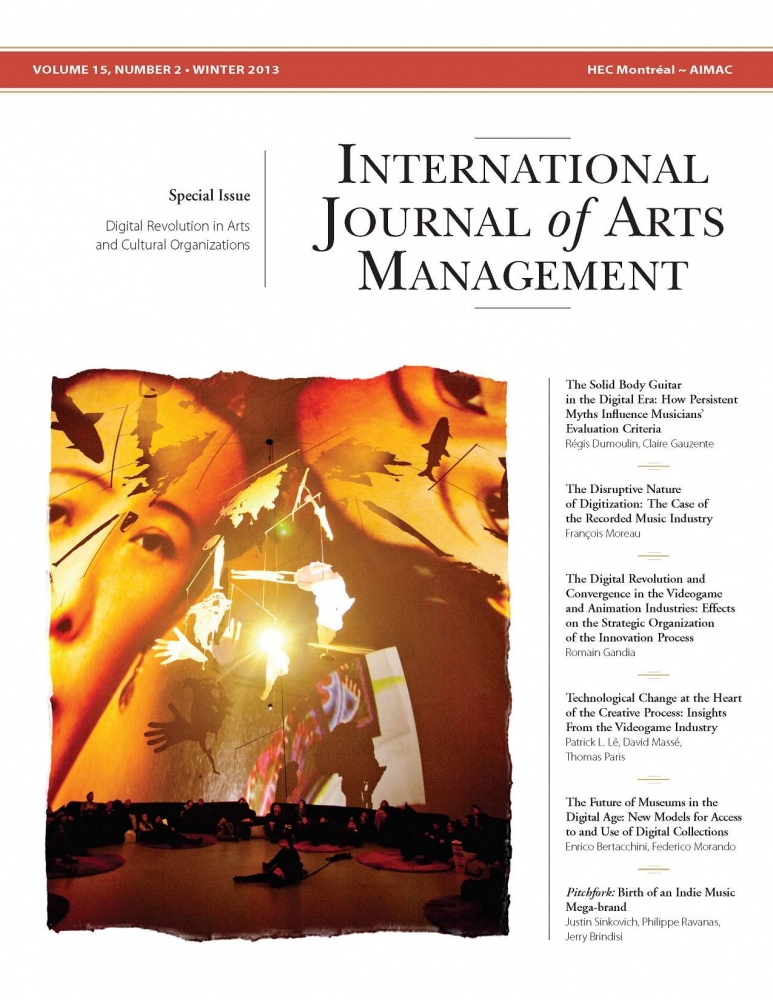IJAM Volume 15 Number 2 (PDF)
Product: Journal
$53.00 CA
GUEST EDITOR'S NOTE
Artistic and Technological Innovation: A Complex Relationship
We are proud to offer our readers this first special issue on the digital revolution in arts and cultural organizations. Arts markets are subject to frequent upheavals triggered by the emergence of innovations. These innovations can be aesthetic – for example, contemporary art versus classical art, contemporary dance versus classical dance, traditional circus versus new circus, nouvelle cuisine versus gourmet cuisine and so on. They can also be technological. In a Schumpeterian process of creative destruction, new technologies give rise to new enterprises and new business models that existing actors either resist or adapt to. In the 19th century, photography caused a radical transformation in the market for paintings. Later, the advent of television called into question the organization of the movie industry. Today, the digital revolution is having a similar transformative effect on all the cultural industries simultaneously.
This issue of IJAM contributes to the debates on the issues and effects of innovation in the cultural industries. It features five research articles and one company profile that highlight resistant behaviour in the face of change, address the complexity of innovation processes and identify new business models based on digital technology.
The articles by Régis Dumoulin and Claire Gauzente and by François Moreau adopt different approaches in their exploration of inertia in the face of change. Dumoulin and Gauzente use the method of netnography to show how three mythic guitars created between 1949 and 1954 (the Telecaster and the Stratocaster by Fender and the Les Paul by Gibson) are, even today, used as a yardstick by musicians exchanging views over the Internet on the respective merits of instruments available on the market. Moreau, for his part, draws from the literature on disruptive technology to explain the lack of responsiveness of major record labels in the face of digital innovations.
The contributions by Romain Gandia and by Patrick L. Lê, David Massé and Thomas Paris explore complex innovation processes in the videogame industry. Gandia looks at the consequences of the convergence of the animated film industry and videogames for the development of new games. Lê, Massé and Paris focus on the relationship between technological innovation and creative innovation. Taking the Ubisoft company as an example, they describe the process of game development based on whether the game is intended for a new console or an existing one. The authors highlight the constant back-and-forth between technological and creative aspects during the development process.
The fifth article, by Enrico Bertacchini and Federico Morando, looks at the implications of digital technology for the promotion of museum holdings. Based on an economic analysis of digital images, they highlight four management models, ranging from simple access to images of artworks on the Internet to the possibility for users to appropriate and modify images using proprietary licensing or open-source tools.
This special issue of the Journal concludes with a company profile by Justin Sinkovich, Philippe Ravanas and Jerry Brindisi in which we learn how a young man from Minneapolis transformed music criticism and founded the most prominent brand in online music journalism, Pitchfork.
Dominique Sagot-Duvauroux
Guest Editor
Johanne Turbide
Editor
